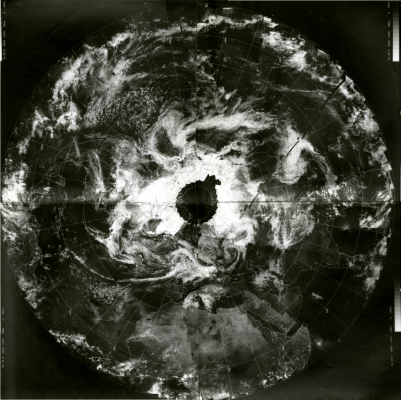Earth from ESSA-9 on the first Earth Day: April 22, 1970
They were called a “weather observatory” or “weather-watching spacecraft” by the news media of the time. The television camera and infrared sensors onboard the ESSA-9 satellite scanned the Earth once a day in a north-south polar orbit, producing images such as this one taken on the first Earth Day, April 22, 1970.
These new technologies ushered in a new era of environmental remote sensing and the imagery that improved the view of weather systems on a global scale.
In addition to the advanced camera system responsible for the Earth imagery, ESSA-9 carried the Flat Plate Radiometer (FPR). Invented by the late Verner Suomi and Robert Parent, founders of the Space Science and Engineering Center, the FPR was a more refined version of their first satellite-borne climate instrument that flew on Explorer 7 in 1959.
Carried on satellites from 1959 until 1970, Suomi’s FPR was designed to measure reflected solar radiation and Earth-emitted radiation from the top of the atmosphere to the Earth’s surface. This earliest data provided a measure of the Earth-Sun energy balance that was foundational to scientists’ growing understanding of climate.
Three decades hence, a similar but more advanced instrument, the Clouds and the Earth’s Radiant Energy System (CERES), was included on Suomi NPP, the latest polar-orbiting weather satellite launched in 2011. The instrument has evolved with scientific contributions from SSEC scientists and continues the collection of data critical to understanding the Earth’s energy balance over longer time frames.
By the 1970s, Suomi had already demonstrated the capability and usefulness of observing weather as-it-happened from geostationary orbit with his spin-scan camera on the Applications Technology Satellite series.
Remotely sensed data and imagery from satellites in geostationary and polar orbit have fundamentally changed the way scientists approach the study of Earth, its environment, and its climate.
Verner Suomi, father of satellite meteorology, is largely credited with establishing the weather satellite program. His contemporary, the late Senator Gaylord Nelson, founder of Earth Day, has become synonymous with the environmental activism of the late 1960s.
They sought change and knowledge from different spheres – one from the world of university science, the other from the political.
Both of them have left lasting imprints on generations of scientists and civilian scientists who aim to understand – and protect – the Earth and the intricacies of its weather and climate.
Sources:
Gaylord Nelson and Earth Day: The making of the modern environmental movement
Storm watch satellite set as pre-Apollo shot. Wisconsin State Journal, Wednesday, February 24, 1969.
Forecast: It’s bright for ESSA. Wisconsin State Journal, Wednesday, May 4, 1966.
By Jean Phillips

